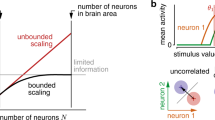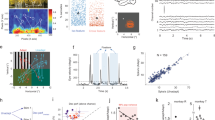Abstract
Sensory neuroscience seeks to understand how the brain encodes natural environments. However, neural coding has largely been studied using simplified stimuli. In order to assess whether the brain's coding strategy depends on the stimulus ensemble, we apply a new information-theoretic method that allows unbiased calculation of neural filters (receptive fields) from responses to natural scenes or other complex signals with strong multipoint correlations. In the cat primary visual cortex we compare responses to natural inputs with those to noise inputs matched for luminance and contrast. We find that neural filters adaptively change with the input ensemble so as to increase the information carried by the neural response about the filtered stimulus. Adaptation affects the spatial frequency composition of the filter, enhancing sensitivity to under-represented frequencies in agreement with optimal encoding arguments. Adaptation occurs over 40 s to many minutes, longer than most previously reported forms of adaptation.
This is a preview of subscription content, access via your institution
Access options
Subscribe to this journal
Receive 51 print issues and online access
$199.00 per year
only $3.90 per issue
Buy this article
- Purchase on Springer Link
- Instant access to full article PDF
Prices may be subject to local taxes which are calculated during checkout




Similar content being viewed by others
References
Theunissen, F. E., Sen, K. & Doupe, A. J. Spectral-temporal receptive fields of nonlinear auditory neurons obtained using natural sounds. J. Neurosci. 20, 2315–2331 (2000)
Sceniak, M. P., Hawken, M. J. & Shapley, R. Contrast-dependent changes in spatial frequency tuning of macaque V1 neurons: effects of a changing receptive field size. J. Neurophysiol. 88, 1363–1373 (2002)
Nolt, M. J., Kumbhani, R. D. & Palmer, L. A. Contrast-dependent spatial summation in the lateral geniculate nucleus and retina of the cat. J. Neurophysiol. 92, 1708–1717 (2004)
Maffei, L., Fiorentini, A. & Bisti, S. Neural correlate of perceptual adaptation to gratings. Science 182, 1036–1038 (1973)
Shapley, R. & Victor, J. D. The contrast gain control of the cat retina. Vision Res. 19, 431–434 (1979)
Shapley, R. M. & Enroth-Cugell, C. in Progress in Retinal Research (eds Osborne, N. N. & Chader, G. J.) 263–346 (Pergamon, Oxford, 1984)
Ohzawa, I., Sclar, G. & Freeman, R. D. Contrast gain control in the cat's visual system. J. Neurophysiol. 54, 651–667 (1985)
Saul, A. B. & Cynader, M. S. Adaptation in single units in visual cortex: The tuning of aftereffects in the spatial domain. Vis. Neurosci. 2, 593–607 (1989)
Smirnakis, S. M., Berry, M. J., Warland, D. K., Bialek, W. & Meister, M. Adaptation of retinal processing to image contrast and spatial scale. Nature 386, 69–73 (1997)
Brenner, N., Bialek, W. & de Ruyter van Steveninck, R. Adaptive rescaling maximizes information transmission. Neuron 26, 695–702 (2000)
Dragoi, V., Sharma, J. & Sur, M. Adaptation-induced plasticity of orientation tuning in adult visual cortex. Neuron 28, 287–298 (2000)
Fairhall, A. L., Lewen, G. D., Bialek, W. & de Ruyter Van Steveninck, R. R. Efficiency and ambiguity in an adaptive neural code. Nature 412, 787–792 (2001)
Chander, D. & Chichilnisky, E. J. Adaptation to temporal contrast in primate and salamander retina. J. Neurosci. 21, 9904–9916 (2001)
Baccus, S. A. & Meister, M. Fast and slow contrast adaptation in retinal circuitry. Neuron 36, 909–919 (2002)
Kohn, A. & Movshon, J. A. Adaptation changes the direction tuning of macaque MT neurons. Nature Neurosci. 7, 764–772 (2004)
Solomon, S. G., Peirce, J. W., Dhruv, N. T. & Lennie, P. Profound contrast adaptation early in the visual pathway. Neuron 42, 155–162 (2004)
Victor, J. D. The dynamics of the cat retinal x-cell centre. J. Physiol. (Lond.) 386, 219–246 (1987)
Brown, S. P. & Masland, R. H. Spatial scale and cellular substrate of contrast adaptation by retinal ganglion cells. Nature Neurosci. 4, 44–51 (2001)
Movshon, J. A. & Lennie, P. Pattern-selective adaptation in visual cortical neurones. Nature 278, 850–852 (1979)
Albrecht, D. G., Farrar, S. B. & Hamilton, D. B. Spatial contrast adaptation characteristics of neurones recorded in the cat's visual cortex. J. Physiol. (Lond.) 347, 713–739 (1984)
David, S. V., Vinje, W. E. & Gallant, J. L. Natural stimulus statistics alter the receptive field structure of V1 neurons. J. Neurosci. 24, 6991–7006 (2004)
Baddeley, R. et al. Responses of neurons in primary and inferior temporal visual cortices to natural scenes. Proc. R. Soc. Lond. B 264, 1775–1783 (1997)
Theunissen, F. E. et al. Estimating spatio-temporal receptive fields of auditory and visual neurons from their responses to natural stimuli. Network 12, 289–316 (2001)
Ringach, D. L., Hawken, M. J. & Shapley, R. Receptive field structure of neurons in monkey primary visual cortex revealed by stimulation with natural image sequences. J. Vis. 2, 12–24 (2002)
Smyth, D., Willmore, B., Baker, G. E., Thompson, I. D. & Tolhurst, D. J. The receptive-field organization of simple cells in primary visual cortex of ferrets under natural scene stimulation. J. Neurosci. 23, 4746–4759 (2003)
Felsen, G., Touryan, J., Han, F. & Dan, Y. Cortical sensitivity to visual features in natural scenes. PLoS Biol. 3, e342 (2005)
de Boer, R. & Kuyper, P. Triggered correlation. IEEE Trans. Biomed. Eng. 15, 169–179 (1968)
Rieke, F., Warland, D., de Ruyter van Steveninck, R. & Bialek, W. B. Spikes: Exploring the Neural Code (MIT Press, Cambridge, Massachusetts, 1997)
Rust, N. C., Schwartz, O., Movshon, J. A. & Simoncelli, E. P. Spatiotemporal elements of macaque v1 receptive fields. Neuron 46, 945–956 (2005)
Sharpee, T., Rust, N. C. & Bialek, W. Analyzing neural responses to natural signals: maximally informative dimensions. Neural Comput. 16, 223–250 (2004)
Ruderman, D. L. & Bialek, W. Statistics of natural images: Scaling in the woods. Phys. Rev. Lett. 73, 814–817 (1994)
Field, D. J. What is the goal of sensory coding? Neural Comput. 6, 559–601 (1994)
Simoncelli, E. P. & Olshausen, B. A. Natural image statistics and neural representation. Annu. Rev. Neurosci. 24, 1193–1216 (2001)
Skottun, B. C. et al. Classifying simple and complex cells on the basis of response modulation. Vision Res. 31, 1079–1086 (1991)
Field, D. J. Relations between the statistics of natural images and the response properties of cortical cells. J. Opt. Soc. Am. A 4, 2379–2394 (1987)
Dong, D. W. & Atick, J. J. Statistics of natural time-varying images. Network 6, 345–358 (1995)
Brenner, N., Strong, S. P., Koberle, R., Bialek, W. & de Ruyter van Steveninck, R. R. Synergy in a neural code. Neural Comput. 12, 1531–1552 (2000)
Blakemore, C. & Campbell, F. W. Adaptation to spatial stimuli. J. Physiol. (Lond.) 200, 11P–13P (1969)
Kvale, M. N. & Schreiner, C. E. Short-term adaptation of auditory receptive fields to dynamic stimuli. J. Neurophysiol. 91, 604–612 (2004)
Wainwright, M. J. Visual adaptation as optimal information transmission. Vision Res. 39, 3960–3974 (1999)
Atick, J. J. & Redlich, A. N. What does the retina know about natural scenes? Neural Comput. 4, 196–210 (1992)
Hosoya, T., Baccus, S. A. & Meister, M. Dynamic predictive coding by the retina. Nature 436, 71–77 (2005)
Dan, Y., Atick, J. J. & Reid, R. C. Efficient coding of natural scenes in the lateral geniculate nucleus: experimental test of a computational theory. J. Neurosci. 16, 3351–3362 (1996)
Emondi, A. A., Rebrik, S. P., Kurgansky, A. V. & Miller, K. D. Tracking neurons recorded from tetrodes across time. J. Neurosci. Methods 135, 95–105 (2004)
Acknowledgements
We acknowledge suggestions from W. Bialek on the design of experiments and subsequent data analysis. We thank M. Caywood, B. St Amant and K. MacLeod for help with experiments. We thank P. Sabes, M. Kvale and S. Palmer for helpful suggestions on statistical aspects of data analysis. Computing resources were provided by the National Science Foundation under the following NSF programs: Partnerships for Advanced Computational Infrastructure at the San Diego Supercomputer Center through an NSF cooperative agreement, Distributed Terascale Facility (DTF) and Terascale Extensions (enhancements to the Extensible Terascale Facility). This research was supported through a grant to K.M. from the National Eye Institute and by a grant from the Swartz Foundation and a career development award from the National Institute of Mental Health to T.S.
Author information
Authors and Affiliations
Corresponding author
Ethics declarations
Competing interests
Reprints and permissions information is available at npg.nature.com/reprintsandpermissions. The authors declare no competing financial interests.
Supplementary information
Supplementary Video 1
This movie shows an example of natural stimulus sequence used in the experiment. Movies were shown without colour.
Supplementary Video 2
This movie compares noise STA and MID filters for cell 856 2.
Supplementary Video 3
This movie compares noise MID and natural MID filters for cell 856 2.
Supplementary Video 4
This movie compares noise STA and MID filters for cell 946 3.
Supplementary Video 5
This movie compares noise MID and natural MID filters for cell 946 3 (QuickTime movie; 467KB).
Supplementary Notes
This file contains Supplementary Discussion, Supplementary Methods and Supplementary Figure Legends.
Supplementary Figure 1
This figure shows the spatial frequency profiles of receptive fields from the two example cells of Figure 1.
Supplementary Figure 2
This figure shows spatial frequency sensitivity on a cell-by-cell basis.
Supplementary Figure 3
This figure shows the nonlinear input/output function P(spike|x)/P(spike) for two example cells.
Supplementary Figure 4
This figure shows the increase in information on a cell-by-cell from adjustments in neural filters following adaptation.
Supplementary Figure 5
This figure shows coarse evolution of adaptation of neural filters.
Supplementary Figure 6
This figure shows dynamics of adaptation to natural stimuli in the beginning and final stages.
Supplementary Figure 7
This figure shows information for a filter derived from noise stimuli and applied to both noise and natural stimuli.
Rights and permissions
About this article
Cite this article
Sharpee, T., Sugihara, H., Kurgansky, A. et al. Adaptive filtering enhances information transmission in visual cortex. Nature 439, 936–942 (2006). https://doi.org/10.1038/nature04519
Received:
Accepted:
Issue Date:
DOI: https://doi.org/10.1038/nature04519
This article is cited by
-
Sensory perception relies on fitness-maximizing codes
Nature Human Behaviour (2023)
-
Attractive and repulsive effects of sensory history concurrently shape visual perception
BMC Biology (2022)
-
Sensory adaptation mediates efficient and unambiguous encoding of natural stimuli by vestibular thalamocortical pathways
Nature Communications (2022)
-
Predictive encoding of motion begins in the primate retina
Nature Neuroscience (2021)
-
Efficient and adaptive sensory codes
Nature Neuroscience (2021)
Comments
By submitting a comment you agree to abide by our Terms and Community Guidelines. If you find something abusive or that does not comply with our terms or guidelines please flag it as inappropriate.



